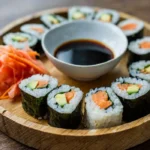
Introduction to Sushi Without Fish
Sushi, a global delicacy, is often synonymous with fish. However, sushi without fish is not only a concept but a growing trend among sushi enthusiasts and those with dietary restrictions. This movement towards fish-free sushi is not new but has gained prominence with the rise of vegetarianism, veganism, and concerns about seafood sustainability. Traditional sushi, with its origins in Southeast Asia and evolution in Japan, has always been about the delicate balance of flavors, and this dish adheres to this tradition by exploring plant-based alternatives.
Why Choose Fish-Free Sushi?
The choice to explore sushi without fish stems from various reasons, ranging from personal health to ethical considerations. Maki Maki Sushi offer a guide to creating delightful sushi that foregoes fish but not flavor, appealing to a broad audience seeking healthier dietary options. Furthermore, the environmental impacts of fishing, highlighted by resources like Sustainable Eating, underscore the urgency of reducing our reliance on seafood. Ethical concerns regarding animal welfare also drive interest in fish-free sushi, presenting an opportunity for sushi lovers to enjoy their favorite dish without compromising their values.
Popular Types of Sushi Without Fish
Sushi without fish encompasses a variety of ingredients, proving that sushi’s essence lies beyond its fish content. Vegetable and fruit options emerge as favorites, offering both traditional and innovative takes on sushi. Examples include:
- Avocado rolls: Creamy textures replacing fish.
- Cucumber rolls: A crunchy, refreshing option.
- Mango rolls: Sweet touches in a savory dish.
- Strawberry rolls: A surprising but delightful combination.
Mock fish and vegan sushi options, leveraging plant-based ingredients to mimic the texture and flavor of traditional seafood, further expand the repertoire of sushi without fish.
Preparing and Enjoying Sushi Without Fish

Ingredients and Preparation Techniques
Creating this recipe starts with selecting the right ingredients and mastering sushi-making techniques. The key to delicious vegan sushi lies in the quality and variety of ingredients used. Essential ingredients include:
- Sushi rice: The foundation of any sushi, its sticky texture holds the roll together.
- Nori sheets: These seaweed wraps are crucial for rolling sushi.
- Vegetables: Avocado, cucumber, bell peppers, and carrots are popular choices.
- Fruits: Mango, strawberries, and pineapple can add a sweet twist.
- Tofu and tempeh: Provide protein-packed alternatives to fish.
Preparation techniques involve cooking sushi rice to perfection, slicing vegetables and fruits thinly to fit into rolls, and mastering the rolling process with a bamboo mat. For detailed guidance, Plant-Based Sushi Ingredients offers a comprehensive look into sourcing and utilizing vegan sushi components.
Different Diets
Sushi without fish caters to a wide range of dietary preferences, including vegan, vegetarian, and gluten-free options. Ensuring that your sushi fits these dietary restrictions involves careful selection of ingredients, such as using tamari instead of traditional soy sauce for a gluten-free alternative. Allergy-friendly substitutions also play a crucial role in accommodating individual needs, making sushi a versatile dish for everyone.
Pairing and Serving Suggestions
Pairing and serving this dish involves creativity and attention to complementary flavors. Consider these suggestions for a complete dining experience:
- Complementary dishes: Serve sushi with miso soup, edamame, or a simple seaweed salad.
- Suggested sauces and condiments: Soy sauce (or tamari), wasabi, and pickled ginger are traditional. For something different, try a sweet chili sauce or a creamy avocado dip.
- Beverage pairings: Green tea is a classic choice, while sake or a light white wine can elevate the meal further.

Comprehensive FAQs Section
- What are the health benefits of eating sushi without fish? Eating this dish can lead to a lower intake of mercury and other contaminants found in seafood, while still providing a rich source of vitamins and minerals from plant-based ingredients.
- Can sushi still be considered authentic without fish? Yes, the essence of sushi lies in its preparation and presentation. Sushi without fish maintains these core principles, offering authentic experiences with alternative ingredients.
- How do I find high-quality ingredients for making sushi without fish at home? Exploring local Asian markets and health food stores can lead to discovering high-quality, authentic ingredients suited for vegan sushi. Online resources and guides can also provide valuable information on sourcing the best ingredients.
Conclusion
In wrapping up our exploration of this recipe, it’s clear that the culinary world offers endless possibilities for creativity and adaptation. Whether you’re catering to dietary preferences or simply looking to explore new flavors, sushi provides a versatile canvas for a variety of ingredients beyond traditional fish. From vibrant vegetable rolls to innovative fruit and mock fish options, there’s a sushi style to suit every palate.
For those interested in broadening their seafood horizons while still keeping within the realm of ethical and sustainable choices, exploring our other seafood recipes can be quite enlightening. Consider checking out our salmon belly recipes for dishes that are both delicious and responsibly sourced, or delve into the world of crustaceans with our crab brulee recipe, which offers another sophisticated option for seafood lovers.
By embracing the full spectrum of this dish and exploring other seafood delicacies, you can enrich your culinary experience and continue to enjoy the art of sushi in new and exciting ways. Happy cooking and dining!

Explore Sushi Without Fish: Vegan Rolls & Recipes
- Total Time: 50 minutes
- Yield: Serves 4
Description
Sushi, a global delicacy, is often synonymous with fish. However, sushi without fish is not only a concept but a growing trend among sushi enthusiasts and those with dietary restrictions. This movement towards fish-free sushi is not new but has gained prominence with the rise of vegetarianism, veganism, and concerns about seafood sustainability. Traditional sushi, with its origins in Southeast Asia and evolution in Japan, has always been about the delicate balance of flavors, and sushi without fish adheres to this tradition by exploring plant-based alternatives.
Ingredients
2 cups sushi rice
2 ½ cups water
½ cup rice vinegar
2 tablespoons sugar
1 teaspoon salt
Nori (seaweed sheets)
1 avocado, sliced
1 cucumber, julienned
1 bell pepper, julienned
Carrot, julienned
Mango, sliced (optional)
Tofu, cut into strips (optional)
Soy sauce, for serving
Pickled ginger, for serving
Wasabi, for serving
Instructions
1. Cook the Sushi Rice:
Rinse the sushi rice under cold water until the water runs clear.
Cook the rice in a rice cooker or pot with 2 ½ cups of water. Once cooked, let it cool slightly.
Mix rice vinegar, sugar, and salt in a small bowl until dissolved. Gently fold this mixture into the cooked rice. Allow the rice to cool to room temperature.
2. Prepare the Vegetables and Fillings:
While the rice is cooling, prepare your fillings by slicing the avocado, cucumber, bell pepper, carrot, and mango into thin strips. If using tofu, pan-fry it lightly until it’s slightly golden and then cut it into strips.
3. Assemble the Sushi:
Place a bamboo rolling mat on your work surface and lay a sheet of nori, shiny side down, on the mat.
Wet your hands (to prevent sticking) and grab a handful of sushi rice. Spread the rice evenly over the nori, leaving about a half-inch of space at the top.
Arrange a small amount of your prepared fillings in a line at the bottom of the rice-covered nori.
4. Roll the Sushi:
Lift the edge of the bamboo mat closest to you, rolling it away from you and over the fillings to start forming the sushi roll.
Gently squeeze the roll as you go to keep it tight. Continue rolling until the entire sheet is rolled up.
Use a little water to moisten the exposed edge of the nori at the end to seal the roll.
5. Cut the Sushi Roll:
With a sharp knife, cut the roll into 6-8 pieces. Wetting the knife between cuts will make for cleaner slices.
6. Serve:
Arrange the sushi on a plate and serve with soy sauce, pickled ginger, and wasabi on the side.
- Prep Time: 30 minutes
- Cook Time: 20 minutes
- Category: SEAFOOD
- Method: No Bake
- Cuisine: ASIAN
Nutrition
- Serving Size: 1 serving
- Calories: 300 calories
- Sugar: 5 grams
- Sodium: 400 mg
- Fat: 7 grams
- Saturated Fat: 1 gram
- Unsaturated Fat: 5 grams
- Trans Fat: 0 grams
- Carbohydrates: 50 grams
- Fiber: 7 grams
- Protein: 8 grams
- Cholesterol: 0 mg
Keywords: sushi without fish, vegan sushi, vegetable sushi rolls, plant-based sushi
